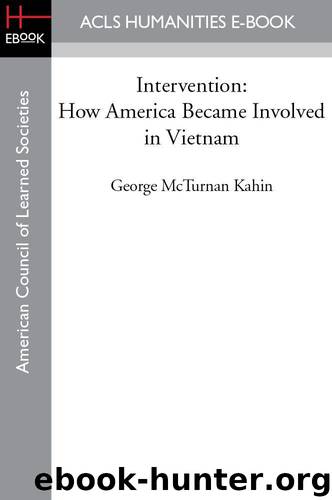Intervention: How America Became Involved in Vietnam by George McTurnan Kahin

Author:George McTurnan Kahin [Kahin, George McTurnan]
Language: eng
Format: epub
ISBN: 9781597409919
Publisher: ACLS Humanities E-Book
Published: 2013-12-16T07:00:00+00:00
Thus Bundy argued that, even if the policy did fail, it was worth undertaking. Despite his admission at the very beginning of his brief that it would mean W,. [Page 284] ‘signifit that *. would be higher-and more visible to American feelins-ha those tag. gin inamiie concluded that “even if it fails to value of ejprt seems to us to exceed cost.”
Immediately after his return to Washington late in the evening of February 7, Bundy presented the full text of his memorandum to the president, with copies distributed to McNamara and Rusk. The next morning, after further discussions with Bundy and with some of his other senior advisers, the president called a meeting of the National Security Council, at which all of his Washington-based senior advisers (except Rusk, who was ill) were present, along with four leading Democratic and Republican congressmen-all of whom, Johnson writes, had read the Bundy report or knew its main elements.46
At the meeting Bundy summarized his report, and Johnson later wrote that among those present there was unanimous support for its “principal recommendation: a program of sustained reprisal against the North.” Some reservations were, however, voiced by Ball and Vice President Humphrey, who a week later wrote a long dissenting memorandum, arguing primarily in terms of domestic political considerations. A subsequent memorandum by Rusk indicated that he too now supported a sustained bombing campaign.47
According to the NSC’s summary notes of the meeting, the president referred to his early-December approval in principle of “further pressure against North Vietnam,” and stated, “We are now ready to return to our program of pushing forward in an effort to defeat North Vietnamese aggression without escalating the war” (emphasis added). He went on to explain that Taylor’s efforts since December had not produced a better government in Saigon, but “it is our hope that current U.S. action may pull together the various forces in Saigon and thus make possible the establishment of a stable government.”48
Johnson’s endorsement of Bundy’s recommendations was in fact somewhat oblique and couched in language sufficiently ambiguous to leave him some latitude regarding actual implementation. The confusion created by this ambiguity was reflected in the questions seeking clarification from Representative Gerald Ford, and in some of Johnson’s responses.49 (Indeed, the president’s position was vague enough to prompt Bundy to plead for elucidation and greater precision a week later.)
Some of the same caution and ambiguity persisted in Johnson’s cable that evening to Taylor:
I am now prepared to go forward with the best government we can get, and accordingly I have today decided that we will carry out our December plan for continuing action against North Vietnam with modifications up and [Page 285] down in tempo and scale in the light of your recommendations as Bundy reports them, and our own continuing review of the situation.... I am impressed by argument that the building of a minimum government will benefit by some private assurances from us to the highest levels that we do now intend to take continuing actions. Therefore
Download
This site does not store any files on its server. We only index and link to content provided by other sites. Please contact the content providers to delete copyright contents if any and email us, we'll remove relevant links or contents immediately.
The Radium Girls by Kate Moore(11585)
100 Deadly Skills by Clint Emerson(4663)
The Templars by Dan Jones(4547)
Rise and Kill First by Ronen Bergman(4537)
The Doomsday Machine by Daniel Ellsberg(4233)
The Rape of Nanking by Iris Chang(4003)
Killing England by Bill O'Reilly(3889)
Hitler in Los Angeles by Steven J. Ross(3787)
Stalin by Stephen Kotkin(3709)
12 Strong by Doug Stanton(3406)
Hitler's Monsters by Eric Kurlander(3142)
Blood and Sand by Alex Von Tunzelmann(3040)
Darkest Hour by Anthony McCarten(3007)
The Code Book by Simon Singh(2837)
The Art of War Visualized by Jessica Hagy(2821)
Hitler's Flying Saucers: A Guide to German Flying Discs of the Second World War by Stevens Henry(2615)
Babylon's Ark by Lawrence Anthony(2420)
The Second World Wars by Victor Davis Hanson(2413)
Tobruk by Peter Fitzsimons(2366)
